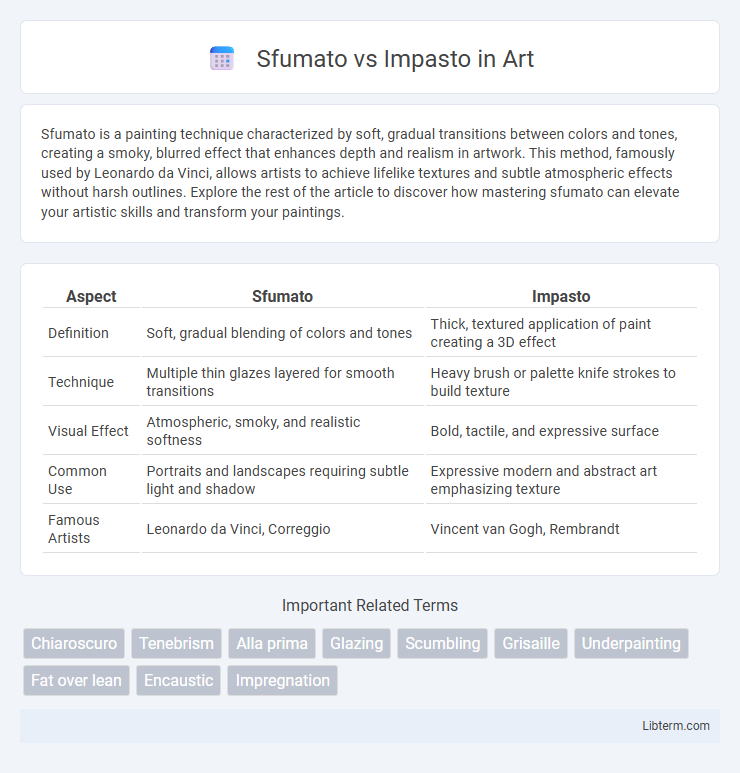Sfumato is a painting technique characterized by soft, gradual transitions between colors and tones, creating a smoky, blurred effect that enhances depth and realism in artwork. This method, famously used by Leonardo da Vinci, allows artists to achieve lifelike textures and subtle atmospheric effects without harsh outlines. Explore the rest of the article to discover how mastering sfumato can elevate your artistic skills and transform your paintings.
Table of Comparison
| Aspect | Sfumato | Impasto |
|---|---|---|
| Definition | Soft, gradual blending of colors and tones | Thick, textured application of paint creating a 3D effect |
| Technique | Multiple thin glazes layered for smooth transitions | Heavy brush or palette knife strokes to build texture |
| Visual Effect | Atmospheric, smoky, and realistic softness | Bold, tactile, and expressive surface |
| Common Use | Portraits and landscapes requiring subtle light and shadow | Expressive modern and abstract art emphasizing texture |
| Famous Artists | Leonardo da Vinci, Correggio | Vincent van Gogh, Rembrandt |
Introduction to Sfumato and Impasto
Sfumato is a painting technique characterized by soft, gradual transitions between colors and tones, creating a smoky, blurred effect that enhances realism and depth. Impasto involves applying thick layers of paint, often with visible brush or palette knife strokes, adding texture and dimensionality to the artwork. Both techniques serve distinct artistic purposes: sfumato emphasizes subtlety and smooth blending, while impasto highlights boldness and tactile surface detail.
Historical Origins of Sfumato
Sfumato, a Renaissance painting technique pioneered by Leonardo da Vinci, originated in the 15th century and is characterized by soft, gradual transitions between colors and tones, creating a smoky, blurred effect without harsh outlines. This technique evolved as artists sought to achieve more realistic and lifelike representations, influenced by the study of light and anatomy. In contrast, Impasto, developed later, involves thick, textured layers of paint to create dimension and vibrant color contrasts, diverging from Sfumato's subtle blending.
Historical Origins of Impasto
Impasto, a painting technique characterized by thick, textured layers of paint, originated during the Renaissance period, gaining prominence through artists like Titian and Rembrandt who used it to add dimensionality and emotional intensity to their works. Unlike Sfumato, which focuses on smooth gradations of tone to create softness and atmospheric effects, Impasto emphasizes physical texture and brushstroke visibility, contributing to a tactile, dynamic surface. This approach historically allowed painters to convey vigorous movement and enhance the visual impact of highlights and shadows, becoming particularly influential in Baroque and later Impressionist art.
Key Characteristics of Sfumato
Sfumato is characterized by its soft, gradual transitions between colors and tones, creating a smoky, blurred effect without harsh outlines, commonly used in Renaissance paintings. This technique relies on meticulous layering of thin glazes to achieve depth and atmospheric perspective, enhancing realism and subtlety in facial expressions and backgrounds. In contrast to impasto, which emphasizes texture through thick, visible brushstrokes, sfumato focuses on smoothness and seamless blending to evoke a delicate, lifelike appearance.
Key Characteristics of Impasto
Impasto is characterized by thick, textured layers of paint that create a three-dimensional surface, allowing light to reflect off the raised paint for a dynamic visual effect. This technique emphasizes bold brushstrokes and tactile qualities, contrasting with the smooth, blended transitions of sfumato. Impasto enhances the sense of movement and emotion in a painting through its pronounced physicality and depth.
Famous Artists Who Used Sfumato
Leonardo da Vinci is the most renowned artist associated with sfumato, masterfully using this technique to create soft transitions and realistic depth in paintings like the Mona Lisa and The Virgin of the Rocks. Caravaggio also employed sfumato elements to enhance dramatic lighting and lifelike textures in his works, blending shadows seamlessly. This technique contrasts with impasto, favored by artists like Vincent van Gogh, who used thick paint layers for texture and expressive brushstrokes rather than the smooth gradients characteristic of sfumato.
Renowned Masters of Impasto Technique
Renowned masters of the impasto technique include Vincent van Gogh, whose thick, textured brushstrokes in works like "Starry Night" create a dynamic, three-dimensional effect. Rembrandt van Rijn utilized impasto to convey intense emotions and intricate detail, particularly in his self-portraits. Impasto allows artists to emphasize texture and light through raised paint layers, contrasting with the subtle blending seen in sfumato.
Visual Effects: Softness vs. Texture
Sfumato creates a visual effect of softness by blending colors and tones seamlessly, producing smooth transitions and a smoky, atmospheric quality. Impasto emphasizes texture through thick, layered paint application that adds dimensionality and tactile depth, making brushstrokes visibly prominent. The contrast between Sfumato's gentle gradations and Impasto's textured surface defines their distinct artistic expressions.
Sfumato vs Impasto: Technique Comparison
Sfumato and impasto are distinct painting techniques that create contrasting visual effects through different applications of paint. Sfumato involves the delicate blending of colors and tones to produce soft transitions and smoky, atmospheric effects, famously used by Leonardo da Vinci in the Mona Lisa. Impasto applies thick layers of paint to create texture and dimensionality on the canvas, often highlighting brushstrokes and adding a tactile quality to the artwork, exemplified by artists like Vincent van Gogh.
Choosing Between Sfumato and Impasto in Art
Choosing between sfumato and impasto depends on the desired texture and depth in a painting. Sfumato creates soft, blended transitions ideal for realistic, atmospheric effects, while impasto emphasizes texture with thick, layered brushstrokes for dynamic, tactile surfaces. Artists should consider the emotional tone and visual impact they want to achieve, as sfumato enhances subtlety and mood, whereas impasto adds physicality and vibrancy.
Sfumato Infographic

 libterm.com
libterm.com